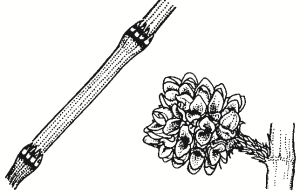Family:
Casuarinaceae
Casuarina cunninghamiana
River Sheoak
Other Names: River Oak, Creek Oak, Fire Oak.

Name Origin:
Casuarina — from Malay Kasuari, from the fancied similarity of the foliage to the drooping feathers of the Cassowary (bird).
cunninghamiana — after Allan Cunningham (1791-1839), pioneering botanist, inland NSW.
Regional Subspecies:
Casuarina cunninghamiana subsp. cunninghamiana
Similar Species:
Closely related to C. glauca, which has larger cones and coarser foliage (not in region).
Occurrence:
Regional:
Along Murrumbidgee River.
Australia:
Qld, NSW, as far south as Murrumbidgee River.
Habitat:
Permanent freshwater streambanks, with roots in or close to water. May be dominant feature of river vegetation.
Habit:
Medium sized tree, 15-35 m high, branchlets drooping in vigorous specimens, or erect in poorer specimens.
Site Preference:
Frost resistant and cold tolerant. Tolerates slight salinity.
Characteristics:
Very fast-growing. Long-lived. Improves soil fertility by ‘fixing’ nitrogen. Name is shortened to C. cunninghamiana in General Native Vegetation Profiles.
Flowering:
Possibly any time of year.
Seed Collection:
Early autumn, before seeds shed. Collect cones by hand, or knock from the trees with poles.
Refrigerate stored seed to retain viability.
Propagation:
From untreated seed which should germinate easily in 2-5 weeks. Optimum germination temperature 30°C. Can be direct sown into pots. Seedlings fast-growing and can be pricked out soon after germination. Easily handled. Innoculate seedlings with solution of crushed root nodules from beneath parent trees.
Regeneration:
From seed, root suckers and coppice after fire. Seedlings highly palatable to livestock, hence fencing recommended to encourage regeneration. Young trees often grow in neat rank downstream from parent trees. Direct seeding at rates of 20-40 grams per km gives natural effect.
VALUES:
Shade & Shelter:
Excellent windbreak tree for medium to high-level cover.
Land Protection:
Very useful for protecting streambanks from erosion by binding banks. May sucker from roots to form colonies, desirable for erosion control.
Wildlife:
Excellent habitat. Parrots extract seeds from cones. Finches eat seed before it is blown from cones. A range of birds nest in the foliage. Good pollen source.
Fuel:
Excellent, burning hot and evenly. Ashes retain heat for long periods. Was used in bakers’ ovens.
Timber:
Decorative, pale-reddish or purplish-brown and fairly light and tough. Used in ornamental turnery and takes a good polish, although may be difficult to work. Straight-grained and fine- textured. Density about 900 kg/m3. Sawn timber may warp and twist excessively during seasoning. May last 15-25 years in ground. Was used to make shingles and staves.
First Nations:
Canoes made from large trees. Shelters made from branches.
Ornamental:
Attractive graceful ornamental. Orchids can be grown on the bark.
Other:
Useful drought fodder. A range of dyes produced from foliage depending on mordants used.
